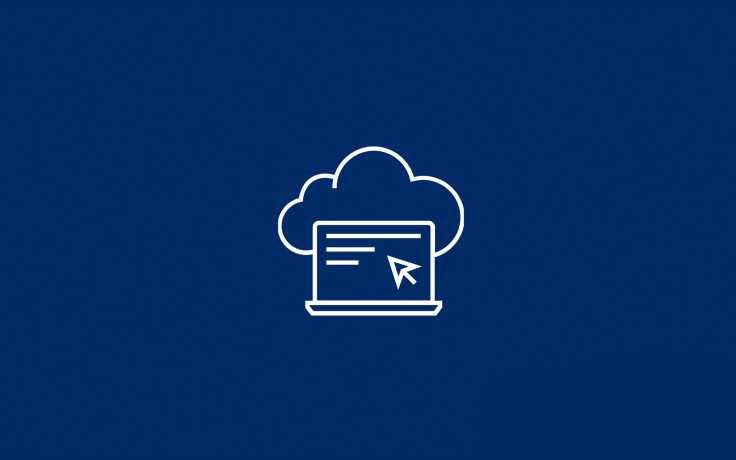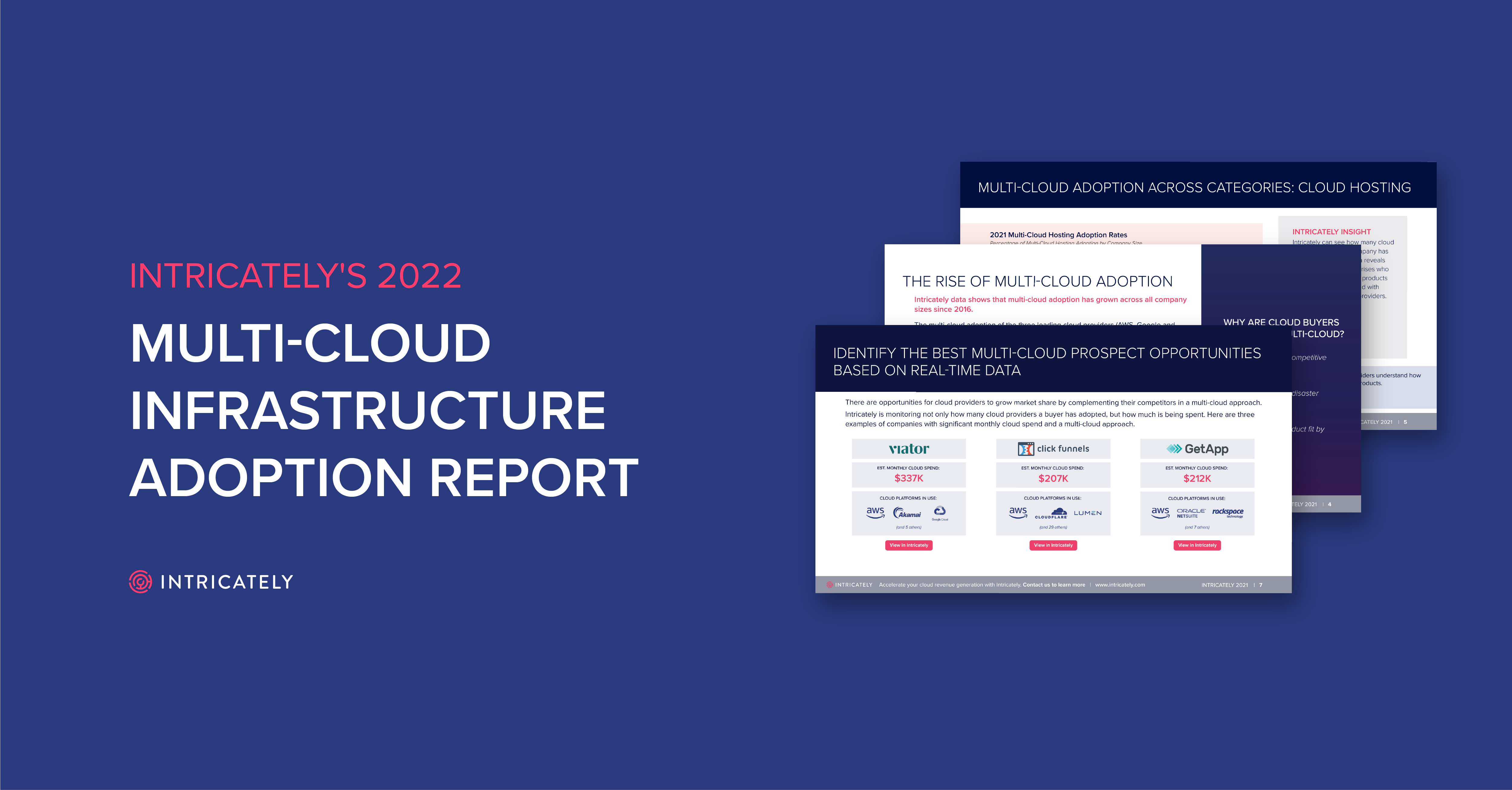 back to all posts
back to all posts
10 Enterprises Leading the Way in Multi-Cloud Architecture

Global spend on public cloud services is projected to exceed $480 billion in 2022, according to Gartner. And as Intricately’s 2022 Multi-Cloud Infrastructure Adoption Report shows, multi-cloud adoption has also been booming. For instance, multi-cloud adoption of the three leading cloud hosting providers (AWS, GCP, and Azure) among large enterprises increased by 20% from 2018 to 2021. Intricately data also reveals that 77% of enterprises investing in cloud hosting solutions are doing so via multiple providers.
As we’ll see later when we highlight ten companies leading the way in multi-cloud adoption, many companies work with several dozen cloud hosting providers and more than a dozen CDNs (content delivery networks). The growth of cloud and multi-cloud adoption offers tremendous benefits for customers/end users looking for more data storage and faster data transmission, as well as massive, untapped sales opportunities for cloud providers.
Several macro-trends are driving the trend towards multi-cloud, including:
- Global markets (and users) are demanding more cloud storage and faster data transmission to their devices. Digital transformation is occurring at both the company level and the individual level.
- Product innovation in the cloud, particularly containerization, has better enabled multiple cloud applications to coexist.
- Multi-cloud offers improved disaster recovery to ensure business and service continuity.
- Flexible, more competitive pricing is available for multi-cloud adoption.
Companies of all sizes around the globe are increasing their cloud investment for the simplest of reasons: the cloud, and multi-cloud adoption, helps them drive better business outcomes and thus remain competitive in addressing market demands for more and faster data.
“Organizations are advancing their timelines on digital business initiatives and moving rapidly to the cloud [and multi-cloud adoption] in an effort to modernize environments, improve system reliability, support hybrid work models and address other new realities compelled by the pandemic,” explains Brandon Medford, Senior Principal Analyst at Gartner.
How sellers can take advantage of multi-cloud revenue opportunities
For cloud sales teams looking to seize the many opportunities represented by growing multi-cloud adoption, cloud technographic data is the fuel that powers any sales strategy and execution. Intricately actively monitors cloud product adoption, usage, and spend of over 7 million global companies of all sizes. Utilizing our data, cloud sellers can easily identify, target, and convert customers and prospects with the highest growth in multi-cloud spend and the highest potential multi-cloud cloud spend.
In the specific context of multi-cloud adoption, Intricately customers typically use our data to develop a multi-cloud sales strategy that includes the following steps:
- Identifying ideal customer profiles that best meet a cloud seller’s offerings;
- Defining the seller's total addressable market;
- Implementing territories and account plans for global sales teams;
- Executing sophisticated marketing programs to drive engagement and revenue growth;
- Benchmarking and assessing sales performance against competitors;
- Prioritizing account-based marketing and sales efforts.
As Intricately data shows, company maturity and size generally correlate to their adoption of multi-cloud solutions, independent of the industry. The larger the company, the more likely they are to use multiple cloud host providers and multiple CDNs. When it comes to enterprises, for example, Intricately data shows that 77% leverage multiple cloud host providers (AWS, Azure, Google Cloud, etc.) and 58% are deploying multiple CDNs. For mid-market companies with 250-1000 employees, those numbers drop to 20% for multi-cloud hosting and 27% for multi-CDNs.
Industries (and enterprises) leading the way
Of course, some industries and specific companies are leading the way on multi-cloud adoption. They are typically industries and companies that use more data, more sensitive data, and/or who need higher data transmission speeds. Let’s look at some of these industries and companies in detail.
Industry: Sports and Entertainment
The MLB (Major League Baseball) is the most historic professional sports league in the United States, consisting of 30 member clubs (who have their own digital assets for their local club) in the U.S. and Canada. With the continued success of MLB Advanced Media and MLB Network, MLB continues to find innovative ways for its fans to enjoy the game through digital channels.
MLB has a massive number of digital assets, including 433 domains and over 3,000 applications.
- Est. monthly cloud spend: $32 million
- Number of cloud hosting providers: 69, including AWS, GCP, and Teradata
- Number of CDN providers: 10, including Akamai, Cloudflare, and Fastly
View MLB's complete digital infrastructure in Intricately.
The New York Times is a globally-respected media outlet that combines print and digital news assets that extend its prestigious brand around the globe. People want their news faster today than ever, and digital news cycles just keep accelerating. The Times owns 110 domains and deploys over 750 applications.
- Est. monthly cloud spend: $25 million
- Number of cloud hosting providers: 41, including AWS, GCP, and DreamHost
- Number of CDN providers: 7, including Fastly, Amazon CloudFront, and Imperva
View The New York Times's complete digital infrastructure in Intricately.
Industry: Retail
Online retail was big before the pandemic, and it’s only accelerated since 2020. While Amazon is the clear global leader in online retail, every retailer now needs a strong digital presence to compete. Hence, the growth of cloud and multi-cloud adoption in retail.
Patagonia is an outdoor apparel company renowned for its commitment to global sustainability, something that has turned its customers into brand loyalists. The California-based company owns 24 domains and has deployed 95 applications total.
- Est. monthly cloud spend: $530,000
- Number of cloud hosting providers: 10, including AWS, GCP, and Azure
- Number of CDN providers: 3, including Akamai and Cloudflare
View Patagonia's complete digital infrastructure in Intricately.
GameStop is a global retailer of multichannel video games, pop culture collectibles, consumer electronics and wireless services, operating more than 5,800 stores globally. The “clicks and bricks” retailer supports 52 domains and 310 applications, spending more than $500,000 per month on the cloud. It works with 19 cloud hosting providers and 9 CDNs.
- Est. monthly cloud spend: $8 million
- Number of cloud hosting providers: 19, including AWS, GCP, and Lumen
- Number of CDN providers: 9, including Amazon CloudFront, Akamai, and Cloudflare
View GameStop's complete digital infrastructure in Intricately.
Industry: Financial services
FinServ is a massive category of cloud and multi-cloud adoption. Financial service companies manage some of the most highly-sensitive data a customer can share with a company: bank account information, tax documents, health-related data, etc. Not only are these service companies using the cloud to transact business digitally, they’re also turning to the cloud for the provision of security in a climate where cyberthreats are growing. Let’s explore how multiple companies in this sector are turning to the cloud.
Banco Santander Mexico, part of the global Santander Group, is a major retail and commercial bank in Central America that uses 23 different domains and over 100 applications. The company is a massive consumer of the cloud and multi-cloud, with a monthly cloud spend north of $500,000. It works with 8 cloud hosting providers and 4 CDNs (including Akamai CDN).
- Est. monthly cloud spend: $2 million+
- Number of cloud hosting providers: 8, including GCP, AWS, and Azure
- Number of CDN providers: 4, including Akamai, Imperva, and Amazon CloudFront
View Banco Santander's complete digital infrastructure in Intricately.
Guardian Life Insurance, based in New York City, serves approximately 29 million people through a range of insurance and financial products, with a strong focus on customer service. Since the pandemic, Guardian has shifted towards the digital transformation of its service provision, supporting 138 domains and 482 applications.
- Est. monthly cloud spend: $250,000
- Number of cloud hosting providers: 27, including AWS, Liquid Web, Inc., and Rackspace
- Number of CDN providers: 6, including Imperva, Akamai, and Cloudflare
View Guardian's complete digital infrastructure in Intricately.
Industry: Travel and Tourism
As more online competitors bring innovation and price advantages to the travel booking space, it’s getting harder to find a “bricks-and-mortar” travel agency anymore. With so much data about price, dynamic pricing models, availability, and customer reviews needed, the travel booking space is as data intensive as it gets. Enter the cloud.
Viator, a TripAdvisor company, is the market leader in destination tours and activities, featuring thousands of in-destination travel activities in more than 2,000 destinations worldwide via its award-winning websites and mobile apps.
- Est. monthly cloud spend: $597,000
- Number of cloud hosting providers: 7, including AWS, Linode, and GCP
- Number of CDN providers: 5, including Fastly, Akamai, and Cloudflare
View Viator's complete digital infrastructure in Intricately.
Hawaiian Airlines is a customer service leader in the travel industry, leading all U.S. carriers in on-time performance since 2004, as reported by the U.S. Department of Transportation. The airline currently supports 15 domains and deploys 207 applications.
- Est. monthly cloud spend: $358,000
- Number of cloud hosting providers: 12, including AWS, Oracle, and Rackspace
- Number of CDN providers: 5, including Akamai, Amazon CloudFront, and Imperva
View Hawaiian Airlines's complete digital infrastructure in Intricately.
Industry: Business Services
The B2B space has long been considered boring and slow-moving. Not anymore, as the quality of business services being sold is accelerating along with emerging technologies like cloud computing. Cloud hosting providers and CDNs are themselves business service providers, of course, offering their customers data storage and high-speed data transmission.
Barcelona-based GetApp is a recommendation engine for small businesses needing to make the right software choices.enables SMBs by delivering tailored, data-driven recommendations and insights necessary to make informed software purchases. The company supports 9 domains and 28 applications.
- Est. monthly cloud spend: $389,000
- Number of cloud hosting providers: 5, including Oracle, Azure, and AWS
- Number of CDN providers: 4, including Amazon CloudFront, Cloudflare, and NGINX
View GetApp's complete digital infrastructure in Intricately.
The global leader in digital media and marketing, Adobe’s creative solutions empower everyone – from emerging artists to global brands – to bring digital creations to life and deliver immersive, compelling experiences to the right person at the right moment for the best results.
- Est. monthly cloud spend: $44 million
- Number of cloud hosting providers: 88, including AWS, Cogent, and MongoDB
- Number of CDN providers: 10, including Akamai, Amazon CloudFront, and Fastly
View Adobe's complete digital infrastructure in Intricately.
The bottom line: A multi-cloud approach to digital infrastructure provides value across all industries
The diversity of industries and companies that we’ve detailed above, all of them accelerating their cloud and multi-cloud adoption, offers a clear signal: opportunities in multi-cloud sales are massive, and only getting bigger. How you identify and target those sales opportunities is up to you, but doing so effectively will require relevant and timely business intelligence and data about a prospect’s cloud usage, current cloud vendors, cloud spend, and cloud spend potential. That’s where Intricately can help.
To learn more about the growing sales opportunities created by multi-cloud adoption, continue reading the 2022 Multi-Cloud Infrastructure Adoption Report.

3 Trends Shaping the Evolving Cloud Hosting Market

4 Ways Cloud Marketing Leaders Can Get the Most From Their Budgets in 2022

How to Perform Account Segmentation and Prioritization


The Importance of Embracing Multi-Cloud Messaging in Your 2022 Selling Strategy


Introducing Intricately's 2022 Multi-Cloud Infrastructure Adoption Report


